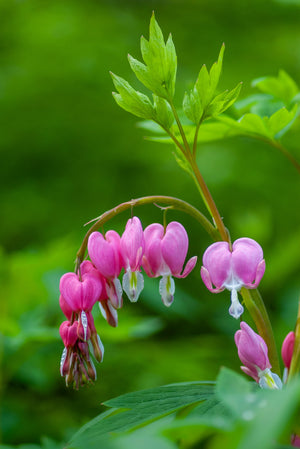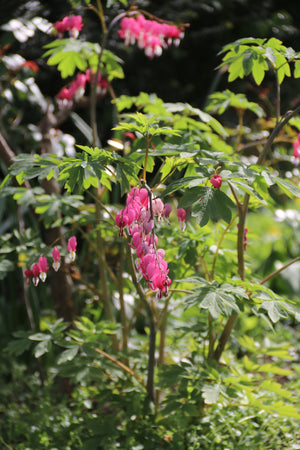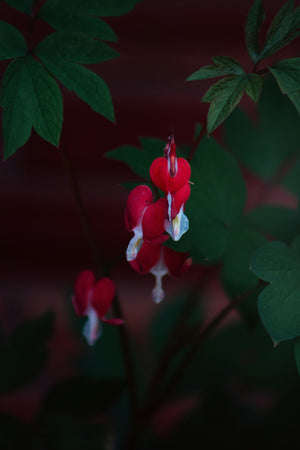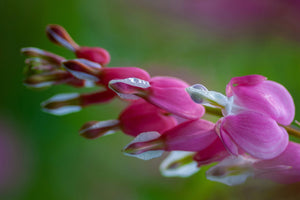The Dicentra Guide
Dicentra, commonly known as bleeding heart, is a beloved genus of woodland perennials admired for their graceful, fern-like foliage and whimsical heart-shaped flowers. These romantic, shade-loving plants have a long history in ornamental horticulture and are valued for their ability to brighten darker corners of the garden with charming spring blooms. Their unusual flower shape and soft textures evoke a timeless beauty in any garden design.

About
Dicentra belongs to the Papaveraceae (poppy) family and includes around 20 species native to North America and Asia. The most iconic species, Dicentra spectabilis, also known as the old-fashioned bleeding heart, features arching stems of pink, white, or red heart-shaped flowers that bloom in late spring. Newer cultivars offer exciting color variations and extended bloom times.
Classic varieties include Dicentra spectabilis 'Alba', with pure white flowers; 'Valentine', known for its deep red blooms and dark foliage; and 'Gold Heart', prized for its vivid chartreuse leaves. Compact, clump-forming species like Dicentra eximia and Dicentra 'King of Hearts' bloom reliably through summer, offering excellent alternatives to the more fleeting springtime varieties. The 'Amore' series—featuring 'Amore Pink', 'Amore Rose', and 'Amore Titanium'—adds vibrant color and long blooming to small-space and container gardens. Additional selections like 'Ruby Gold' and 'Pink Diamonds' continue to expand the palette and interest.
Dicentra’s delicate, lacy foliage and its striking, pendulous flowers make it a standout in woodland gardens, shade borders, and naturalized plantings.

PLANTING
Dicentra is at its best when planted in cool, shaded spots with rich, well-drained soil. Proper planting helps ensure its long-term success and steady blooming:
- USDA Hardiness Zones: Most species are hardy in Zones 3–9.
- Soil: Prefers humus-rich, moist, well-drained soil with slightly acidic to neutral pH.
- Sunlight: Partial to full shade is ideal. Some species tolerate morning sun, but intense afternoon sun can scorch foliage.
- Watering: Keep soil evenly moist, especially during dry spells. Avoid soggy soil which can cause root rot.
- Spacing: Space plants 12–18 inches apart depending on the mature size of the cultivar.
- Planting Time: Plant in spring or fall when temperatures are cool. Mulch to retain moisture and regulate soil temperature.
When planting bare-root Dicentra, ensure that the crown is just at or below soil level. Water well after planting and mulch with leaf mold or compost for added organic matter.

CARE
While generally low maintenance, Dicentra appreciates a little attention to keep it thriving throughout the season:
- Watering: Consistent moisture is important, especially in warmer months. Water at the base to avoid wetting foliage.
- Fertilizing: Apply a slow-release or organic fertilizer in early spring to support vigorous growth and flowering.
- Pruning: Remove spent flower stems to encourage reblooming. Trim back foliage after it yellows and dies back naturally in midsummer.
- Mulching: Use a light layer of organic mulch to help retain soil moisture and reduce weeds.
- Pests & Diseases: Dicentra is generally pest-resistant but may be susceptible to aphids, slugs, or powdery mildew in overly damp conditions.
- Dividing: Divide clumps every 3–4 years in early spring or fall to rejuvenate growth and maintain vigor.

HOW TO USE
Dicentra provides texture, movement, and seasonal flair in shady spaces. Their unique form and bloom timing make them valuable players in garden design:
- Woodland Gardens: Ideal among hostas, ferns, and native groundcovers where they can naturalize with ease.
- Shade Borders: Plant alongside astilbe, heuchera, brunnera, and tiarella for continuous shade-season interest.
- Cutting Gardens: Bleeding heart blooms make enchanting additions to spring bouquets.
- Containers: Dwarf varieties like 'Amore Titanium' and 'Luxuriant' thrive in pots for patios or shady entryways.
- Understory Plantings: Perfect beneath deciduous trees where they can emerge early and die back gracefully by midsummer.
Their fern-like foliage and distinctive flowers pair well with spring ephemerals and shade perennials. For contrast and layered planting, consider mixing Dicentra with hellebores, pulmonaria, or anemone.

COMMON QUESTIONS
- How to plant Dicentra? Plant in moist, well-drained soil in partial to full shade. Space 12–18 inches apart and mulch after planting.
- Are Dicentra poisonous to dogs? Yes, all parts of the plant are toxic to dogs if ingested.
- Are Dicentra poisonous to cats? Yes, Dicentra is also toxic to cats and should be planted with caution around pets.
- Do deer eat Dicentra? Dicentra is generally deer resistant thanks to its bitter foliage.
- How to grow Dicentra? Provide shade, moist soil, regular watering, and allow plants to go dormant in summer without disturbance.
- Is Dicentra a perennial? Yes, most species are long-lived perennials that return each spring.
- When do Dicentra flower? Dicentra typically blooms in mid to late spring. Some varieties continue blooming sporadically into summer.
Conclusion
With their poetic flowers and graceful, finely textured foliage, Dicentra plants bring a serene elegance to shaded gardens and woodland borders. Whether you love the classic beauty of Dicentra spectabilis or the compact, everblooming vigor of the 'Amore' series, bleeding hearts are garden treasures that evoke nostalgia and romance. Easy to grow and striking in bloom, Dicentra offers color, form, and charm where many other perennials fall short.
The Dicentra Collection
Sold Out
Sold Out
Sold Out






